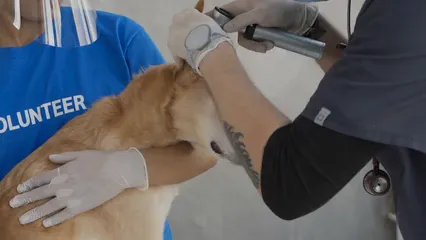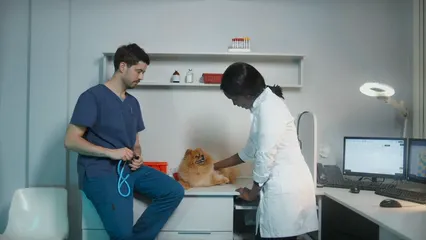Introduction
Are you curious about how long dogs are pregnant? Understanding dog pregnancy is essential for both pet owners and breeders. It helps in preparing for the arrival of adorable puppies and ensures the mother’s health.
On average, a dog’s gestation period lasts about 63 days. Knowing this timeframe is crucial for tracking your dog’s health and planning for the new arrivals. This article will cover various aspects of dog pregnancy, from signs and stages to care tips and labor.

Summary and Overview
The gestation period for dogs typically ranges from 56 to 70 days. Most pregnancies average around 63 days. However, some factors can affect this timeframe, such as the dog’s breed, size, and overall health.
In this guide, we will discuss the following topics:
- Signs of pregnancy
- Stages of pregnancy
- Care for the pregnant dog
- Understanding labor and delivery
By the end, you’ll have a solid understanding of what to expect during this exciting time. And don’t forget, a whelping box for dogs is essential for a safe and comfortable delivery space.

Understanding the Canine Reproductive Cycle
Understanding a dog’s reproductive cycle is essential for recognizing pregnancy. It consists of four stages: Proestrus, Estrus, Diestrus, and Anestrus.
Overview of the Heat Cycle
The heat cycle begins with Proestrus. This stage lasts about nine days. During this time, the female dog experiences a swollen vulva and bloody discharge. However, she is not yet receptive to males.
Next comes Estrus, which lasts 3 to 11 days. Here, the vulva remains enlarged, and the discharge becomes lighter. This is the time when the female is ready to mate.
Following Estrus is Diestrus, lasting around two months. In this phase, the dog is no longer receptive. The vulva returns to normal, and the discharge may become redder before tapering off.
Finally, Anestrus lasts roughly four months. This is a resting phase where the uterus prepares for the next cycle. Tracking these stages helps determine the timing of mating and potential conception.
Implications for Pregnancy Timing
Knowing the heat cycle aids in predicting pregnancy timing. Mating should occur during Estrus for the best chance of conception. For breeders, tracking heat cycles is crucial. On average, female dogs go into heat about every six months, but this can vary by breed. Each heat cycle typically lasts 18 to 21 days, making it important to monitor your dog closely.
By understanding the canine reproductive cycle, you can better anticipate when your dog may become pregnant. This knowledge is not only valuable for breeders but also for any dog owner wanting to ensure their pet’s health and wellbeing. And while you’re at it, consider picking up a dog health monitoring book to keep track of your dog’s health during pregnancy.

Signs and Symptoms of Dog Pregnancy
Early Signs (Weeks 1-4)
Pregnancy often brings noticeable changes in your dog. During the first few weeks, you may see shifts in appetite and behavior. Your dog might become more affectionate or, conversely, a bit irritable. Physical signs can be subtle initially.
Some dogs experience morning sickness, which can include vomiting. You might also notice slightly enlarged nipples and a clear vaginal discharge. These signs may not be obvious but are essential to watch for during this early stage.

Later Signs (Weeks 5-9)
As your dog’s pregnancy progresses into weeks five through nine, you’ll notice significant changes. One of the most apparent signs is weight gain. Your dog may also develop a swollen abdomen, signaling that the puppies are growing. Have you noticed her indulging in more frequent meals? This is common as her appetite increases.
Nesting behavior is another key indicator. You might catch her rearranging blankets or seeking out cozy spots to prepare for her puppies. This instinct is perfectly natural and indicates she’s getting ready for the big day. To help with this, ensure you have a good supply of puppy pads for training handy for those first few weeks.
Around week six, you may begin to feel tiny movements in her belly. It’s an exciting moment to witness! These little kicks and rolls indicate that the puppies are active and developing. If you haven’t yet, now is a great time to consult your veterinarian. They can confirm the pregnancy and help ensure both your dog and her puppies remain healthy throughout this journey.
For more information on how to confirm a dog’s pregnancy, check out this dog pregnancy test.

How to Confirm a Dog’s Pregnancy
Veterinary Methods
Confirming your dog’s pregnancy is essential for proper care. Veterinarians use several methods to do this, starting with hormone tests. These tests detect the hormone relaxin, which is produced only during pregnancy. This test is most accurate about 30 days after conception.
Another common method is abdominal palpation. Veterinarians can gently feel the abdomen for developing embryos around three to four weeks into the pregnancy. This technique, while effective, requires some experience.
Ultrasounds are also a reliable option. They can confirm pregnancy between days 25 and 35. This method allows for monitoring the heartbeats of the puppies. Finally, X-rays can be utilized later in the pregnancy, typically from day 55 onward, to count the number of puppies.
Each method has its timing and purpose. For the best results, consult your veterinarian to determine which test is appropriate for your dog’s stage of pregnancy. And while you’re at it, a dog first aid kit is a smart investment for any dog owner!

The Stages of Dog Pregnancy
First Month (Days 1-30)
During the first month, your dog undergoes significant internal changes. After successful mating, fertilized eggs travel to the uterus. Here, they embed into the uterine lining, marking the start of pregnancy.
In these early days, you might not see many obvious signs. However, some dogs exhibit changes in appetite. Increased affection or occasional lethargy can also be noticeable. By the end of the first month, slight physical changes may appear. These include enlarged nipples and a clearer vaginal discharge.
As the weeks progress, many owners report increased interest in their dog’s well-being. Being attentive during this stage is crucial for monitoring her health as the puppies begin to develop. Expect to see more distinct signs in the coming weeks as the pregnancy advances. And don’t forget to have a heating pad for pets ready to keep her comfortable!

Second Month (Days 31-60)
In the second month, your dog experiences rapid fetal development. By this time, the embryos are transforming into recognizable puppies. You might notice your dog gaining weight significantly. An increase of 20% to 50% in weight is common during this stage.
Behaviorally, changes become more pronounced. Many dogs show heightened affection or, conversely, slight irritability. You may also observe changes in appetite. Initially, she may eat more, but this can taper off around the 45th day.
As the pregnancy progresses, signs become more evident. A firm, enlarged abdomen will be noticeable, and you may even see or feel movements from the puppies. By the end of this month, it’s a good idea to consult your veterinarian for a check-up. Regular vet visits ensure your dog remains healthy and can address any concerns you might have. And don’t forget to stock up on dog food for pregnant dogs to ensure she has the nutrients she needs!
Third Month (Days 61-63)
As the due date approaches, your dog prepares for whelping. This is the final stage of pregnancy, lasting only a few days. You may notice several behavioral signs indicating that labor is imminent. Your dog might become restless, pacing around her environment. Nesting behavior can start as she searches for a safe spot to deliver her puppies.
Physically, you may see appetite loss as she prepares for labor. A drop in body temperature often occurs 12 to 24 hours before labor begins. This drop signals that whelping is near, and you should be ready. Keep a close eye on her for any signs of distress or complications.
During this stage, it’s crucial to create a comfortable whelping area. Ensure it’s quiet and free from distractions. Gather necessary supplies, like clean towels and a puppy scale for weighing newborns to monitor their growth after birth.

Preparing for Whelping
Creating a cozy and safe whelping area is essential for your dog. Start by choosing a quiet space away from daily commotion. A whelping box is a great option. Line it with clean blankets or puppy pads to keep it comfortable and hygienic.
Gathering supplies in advance is key. You’ll need clean towels for drying puppies, scissors for cutting umbilical cords, and a heating pad to keep them warm. A scale can help you monitor their weight after birth. And let’s not forget about the importance of a dog leash and collar set for post-whelping walks!
Don’t forget to have your vet’s contact information handy. They can provide guidance and support as needed. Preparing well in advance ensures a smooth birthing process for both you and your dog.

Understanding Dog Labor and Delivery
Stages of Labor
Dog labor occurs in three distinct stages. First, the preparatory stage lasts about 12 to 24 hours. Your dog may seem restless and start nesting. Look for signs like panting and whining during this time.
Next is the delivery of puppies, which can take 1 to 24 hours. Puppies are born every 30 to 60 minutes. Ensure you keep the area clean and calm during this phase.
Finally, the expulsion of placentas happens shortly after each puppy. Each placenta should be delivered within a few hours. If your dog seems distressed or if significant time passes between puppies, contact your vet.
When to Seek Veterinary Assistance
It’s crucial to know when to call your veterinarian during labor. If your dog struggles to deliver a puppy for more than two hours, it’s time to reach out for help. Additionally, if she shows signs of distress, such as excessive bleeding or prolonged contractions without delivery, seek immediate assistance.
Common complications include a puppy being stuck in the birth canal or maternal exhaustion. Staying calm and supportive is vital. Your presence can provide comfort during this stressful time, ensuring a smoother experience for your dog. And remember, having a dog first aid kit on hand can be a lifesaver in emergencies!
As you prepare for your dog’s labor, remember that your role is essential. Being informed and ready can make all the difference.
Please let us know what you think about our content by leaving a comment down below!
Thank you for reading till here 🙂
All images from Pexels





